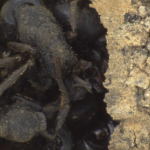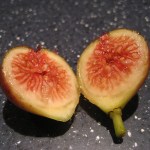wasp
Bone-house wasps protect their young by building walls made of ant carcasses. Image from: Merten Ehmig
A new species of spider wasp that protect their young with walls made of ant carcasses has been discovered in the forests of China. Dr. Michael Staab from the University of Freiburg discovered the new species which he named Deuteragenia ossarium meaning "bone-house wasp" since the wasps reminded him of the ossuaries in Europe with structures decorated from human bones.
Sedlec Ossuary in the Czech Republic. Image from Wikipedia.
Similar to the ossuaries, the bone-house wasps use alive…
A delightful lunch conversation about fruits introduced me to what may be my new favorite symbiotic relationship! Figs are not actually fruits but a mass of inverted flowers and seeds that are pollinated by a species of tiny symbiotic wasps. The male fig flower is the only place where the female wasp can lay her eggs, at the bottom of a narrow opening in the fruit that she shimmies her way through. The baby wasps mature inside the fig into males that have sharp teeth but no wings and females ready to fly. They mate, the males chew through the special fig pollen holders and drop them down to…
It's not every day that you hear about spy missions that involve a lack of sex, but clearly parasitic wasps don't pay much attention to Hollywood clichés.
These insects merge the thriller, science-fiction and horror genres, They lay their eggs inside other animals, turning them into slaves and living larders that are destined to be eaten inside-out by the developing grubs. To find their victims, they perform feats of espionage worthy of any secret agent, tapping into their mark's communication lines, tailing them back to their homes and infiltrating their families.
Two species of…
Viruses and bacteria often act as parasites, infecting a host, reproducing at its expense and causing disease and death. But not always - sometimes, their infections are positively beneficial and on rare occasions, they can actually defend their hosts from parasitism rather than playing the role themselves.
In the body of one species of aphid, a bacterium and a virus have formed a unlikely partnership to defend their host from a lethal wasp called Aphidius ervi. The wasp turns aphids into living larders for its larvae, laying eggs inside unfortunate animals that are eventually eaten from…
It's a scene straight out of a horror film - you look around and see dead bodies everywhere. They haven't just been killed either, they've been hollowed out from the inside-out leaving behind grotesque mummified shells. What would you do if you were confronted with such a macabre scene? Flee? Well, if you were an aphid, you'd probably just feel relieved and go about your business. Aphids, it seems, find security among the corpses of their peers.
Aphids, like almost all insects, are the targets of parasitic wasps that implant eggs inside their bodies. On hatching, the wasp grubs use the aphid…
This is the seventh of eight posts on evolutionary research to celebrate Darwin's bicentennial. It combines many of my favourite topics - symbiosis, horizontal gene transfer, parasitic wasps and viruses.
Parasitic wasps make a living by snatching the bodies of other insects and using them as living incubators for their grubs. Some species target caterpillars, and subdue them with a biological weapon. They inject the victim with "virus-like particles" called polydnaviruses (PDVs), which weaken its immune system and leave the wasp grub to develop unopposed. Without the infection, the wasp egg…
This is the second of eight posts on evolutionary research to celebrate Darwin's bicentennial.
What do you get when one species splits into separate lineages? Two species? Think bigger...
When new species arise, they can set off evolutionary chain reactions that cause even more new species to spring forth - fresh buds on the tree of life create conditions that encourage more budding on different branches.
Biologists have long suspected that these "cascades of speciation" exist but have struggled to test them. Enter Andrew Forbes from the University of Notre Dame - his team of has…
Heterospilus sp., head & compound eye, Costa Rica
Here are some shots from my training session this morning at the Beckman Institute's Scanning Electron Microscope (SEM). I haven't used SEM for years- wow! Great fun. Click on each image to enlarge.
Heterospilus sp. mesosoma
Heterospilus sp., ovipositor
For contrast, here's a photo of a wasp in the same genus taken with my standard Canon macro gear:
Heterospilus sp. Costa Rica, taken with a Canon 20D dSLR & macro lens
We'll be deciding over the coming months which type of images to use for our project.Â…
tags: Lucasberg, wasp, Hymenoptera, behavior, streaming video
This streaming video is a fascinating close-up interaction with a wasp by the photographer, who goes by the name Lucasberg. To get these amazing shots, he used a 180mm SLR macro lens. The photographer says the video is a little shakey because he was balancing on the handrail of his porch and could only use 1 tripod leg while filming. [1:06].
Face to face with a Wasp.
A few weeks back we brought you a story on the Schmidt Sting Pain Index, a system developed to compare the relative intensity of Hymenoptera (bees, wasps and ants) stings. The index was developed through personal "research" conducted unintentionally by Dr. Justin Schmidt, an entomologist who has devoted his life to these ornery critters.
As the Index combines all the things Zooillogix readers love (i.e. science and non-life threatening personal injury) the response to the post was strong. Therefore in collaboration with Shelley Batts, formerly of Retrospectacle and now the brand new…
Humans are now one large step closer to producing armies of undead, zombie hordes who live only to feast on the brains of the living and reproduce by infecting non-zombies with their "zombie virus" through their saliva or other bodily fluids. This is thanks to the work of a team of scientists at Ben-Gurion University of the Negev in Israel, who have documented a kind of wasp that zombifies cockroaches.
Ampulex compressa enjoys licking pieces of wood, long walks on the beach and necromancy.
The Ampulex compressa actually stings a roach twice, once to disable it, and again (this time…

